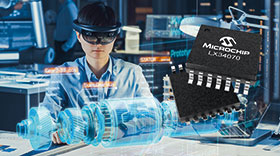

Developers of motor control systems are rapidly replacing Hall effect position sensors and older magnetic resolver solutions with inductive alternatives that eliminate expensive magnets and other transformer-based structures so they can be integrated onto simple, compact PCBs. Extending the line of inductive position sensors into the EV motor control market, Microchip has announced the LX34070 IC that has been purpose-built for EV motor control applications. The IC includes differential outputs, fast sample rates and features that make it functional-safety-ready for ISO 26262 compliance in the Automotive Safety Integrity Level–C (ASIL–C) classification.
“The LX34070 inductive position sensor enables lighter, smaller, more reliable motor control solutions that meet stringent safety requirements, reduce overall system costs, and can operate seamlessly and precisely in the noisy environment of an automobile’s DC motors, high currents and solenoids” said Fanie Duvenhage, vice president of Microchip’s mixed signal and linear analog business unit. “Designers can use the LX34070 to further streamline EV motor control designs by pairing it with other functional-safety-ready Microchip devices including our 8-bit AVR and PIC microcontrollers, our 32-bit microcontrollers, and our dsPIC digital signal controllers.”
The LX34070 inductive position sensor solution offers numerous advantages compared to magnetic resolvers and linear voltage differential transducers (LVDTs), at a fraction of the cost. By using PCB traces rather than transformer-based magnetic windings and coil structures, the LX34070 device has negligible size and mass compared to alternatives. Accuracy is improved since the LX34070 does not depend on magnetic field strength, and the device improves robustness by actively rejecting stray magnetic fields. This allows designers greater flexibility over where they can position the PCB-based LX34070 solution in their EV motor control designs.
PCB-based inductive position sensors use a primary coil to generate an AC magnetic field that couples with two secondary coils. A small metal target object disturbs the magnetic field so that each secondary coil receives a different voltage whose ratio is used to calculate absolute position. Using these techniques, Microchip introduced its first high-volume inductive sensor for automotive and industrial applications over a decade ago and has many programmes in volume production. The LX34070 now brings the same proven PCB materials, approaches and simplified, low-cost packaging to EV motor control and other applications that need its high-speed and low-latency benefits.
| Tel: | +27 11 923 9600 |
| Email: | [email protected] |
| www: | www.altronarrow.com |
| Articles: | More information and articles about Altron Arrow |

© Technews Publishing (Pty) Ltd | All Rights Reserved